Einleitung
Hallo habr Heute möchte ich ein wenig darüber sprechen, wie Sie mit der
Lightweight Rendering Pipeline (LWRP) - einem der Beispiele für die
Scriptable Rendering Pipeline (SRP) - schnell und schmerzlos (fast) mit dem Schreiben klassischer
Textshader in Unity beginnen können.
Aber was ist mit dem Shader Graph?
Shader Graph ist ein praktisches und schnelles Werkzeug zum Erstellen von Prototypen oder zum Schreiben einfacher Effekte. Manchmal ist es jedoch notwendig, etwas Kompliziertes und Komplexes zu schreiben, und dann - die Anzahl der Knoten, benutzerdefinierten Funktionen und Subgraphen nimmt unglaublich zu, weshalb selbst der erfahrenste Grafikprogrammierer in diesem ganzen Durcheinander verwirrt zu werden beginnt. Wir alle wissen, dass der automatisch generierte Code a priori nicht besser als manuell geschrieben sein kann - Sie müssen nicht weit gehen, um Beispiele zu nennen, da ein Fehler im Layout der Knoten dazu führen kann, dass das bereits bekannte Berechnungsergebnis im Vertex-Shader wiederholt im Fragment gezählt wird. Es gibt Leute, die es einfacher haben, mit
Code zu arbeiten , als mit Knoten. Die Gründe mögen unterschiedlich sein, aber das Wesentliche ist dasselbe - mit den Knoten, es lebe der Code!
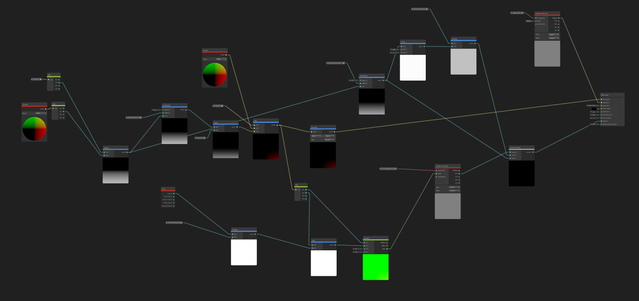
Ausgabe
Was ist also das Problem, sich hinzusetzen und einen regulären Text-Shader unter LWRP zu schreiben? Und das Problem ist, dass in LWRP nicht alle gängigen
Standard Surface Shader unterstützt werden.
Bei dem Versuch, es zu verwenden, erhalten wir Folgendes:
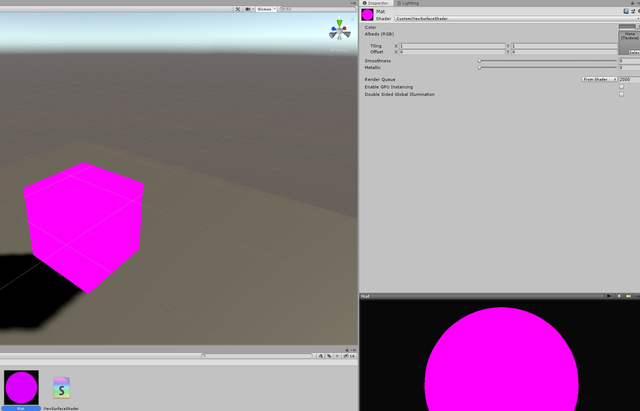
Shader-CodeShader "Custom/NewSurfaceShader" { Properties { _Color ("Color", Color) = (1,1,1,1) _MainTex ("Albedo (RGB)", 2D) = "white" {} _Glossiness ("Smoothness", Range(0,1)) = 0.5 _Metallic ("Metallic", Range(0,1)) = 0.0 } SubShader { Tags { "RenderType"="Opaque" } LOD 200 CGPROGRAM
Dann fällt es mir ein, zu versuchen, einen regulären Anlite-Shader mit einem Vertex- und Fragmentteil zu schreiben. Und zum Glück funktioniert alles:

Shader-Code Shader "Unlit/NewUnlitShader" { Properties { _MainTex ("Texture", 2D) = "white" {} } SubShader { Tags { "RenderType"="Opaque" } LOD 100 Pass { CGPROGRAM #pragma vertex vert #pragma fragment frag
Aber wie kannst du nicht traurig sein - wir schienen nackt am Spielfeldrand ohne Licht, Schatten, Lichtkarten und geliebte Züchterrechte zu stehen, ohne die das Leben nicht süß wäre.
Natürlich können Sie alles von Hand schreiben:
Lass es hell sein!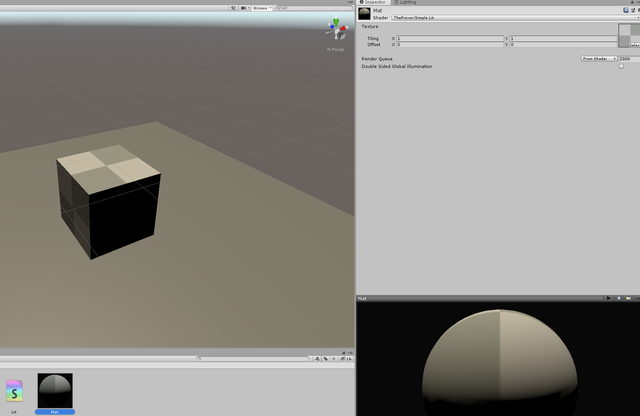
Shader-Code Shader "TheProxor/Simple Lit" { Properties { _MainTex("Texture", 2D) = "white" {} } SubShader { Tags { "RenderType" = "Opaque" } LOD 100 Pass { CGPROGRAM #pragma vertex vert #pragma fragment frag
Alles scheint zu funktionieren, aber das ist nur diffuses Licht. Was ist als nächstes zu tun? Sie können weiterhin alles von Hand zurückgeben, aber es ist lang und trostlos, und PBR kann in keiner Weise zurückgegeben werden, und wir verlieren alle LWRP-Chips. Daher haben wir keine andere Wahl, als LWRP zu wählen, um alles mit einem magischen Strich zurückzugeben.
Lösung
Wie Sie wissen, basiert LWRP auf dem
Forward-Renderer , dh es verfügt über einen eigenen LitForwardPass, der irgendwo beschrieben werden sollte. Offensichtlich gibt es irgendwo ein CGInclude, in dem dies alles beschrieben ist. Hier starten wir zu einem lustigen Abenteuer in:
% localappdata% \ Unity \ cache \ packages \ packages.unity.com \ com.unity.render-pipelines.lightweight @ (LWRP-Version) \
Nachdem wir die angegebene Adresse erreicht haben und in den
Shader- Ordner gegangen sind, finden wir einen interessanten Shader namens
Lit.shader . Eigentlich können wir sagen, unsere Suche ist vorbei, hier ist es - der begehrte Shader. Gehen Sie hinein - wir finden folgenden Inhalt:
Lit.shader Shader "Lightweight Render Pipeline/Lit" { Properties {
Es bleibt nur zu erweitern, um die Bearbeitung zu vereinfachen und Include-s zu entfernen. Nun, ein bisschen auf deine eigene Art modifizieren.
Wir bekommen so etwas:
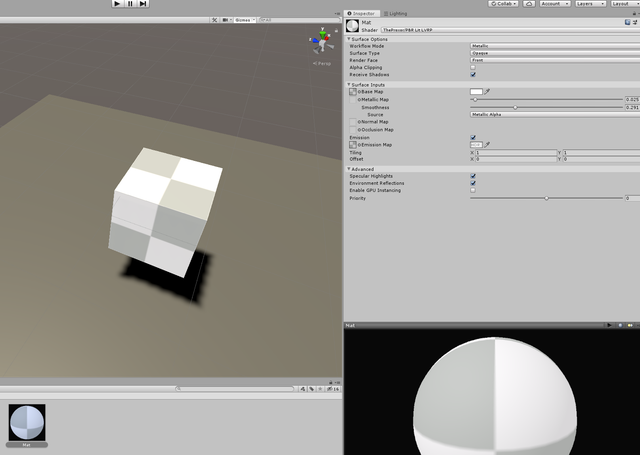
Letzter Uber Shader Shader "TheProxor/LWRP/Dissolve + Vertex Offset" { Properties {
Zunächst müssen Sie herausfinden, was in dem resultierenden Shader enthalten ist. Erstens interessieren wir uns für die Linie:
CustomEditor "UnityEditor.Rendering.LWRP.ShaderGUI.LitShaderEditor"
Wie wir uns erinnern, lautete das Original wie folgt:
CustomEditor "UnityEditor.Rendering.LWRP.ShaderGUI.LitShader"
Also was ist es und warum ist es? Die Antwort auf diese Frage ist ganz einfach: Wenn Sie genau hinschauen, gibt es im Shader eine große Anzahl verschiedener Definitionstypen, die seltsamerweise aktiviert und deaktiviert werden müssen. Dies muss für einen Moment über den Code erfolgen, weshalb wir einen benutzerdefinierten Inspektor benötigen. Darüber hinaus sollte unser benutzerdefinierter Inspektor uns die Möglichkeit geben, nicht nur die integrierten Eigenschaften, sondern auch die Eigenschaften zu bearbeiten, die wir möglicherweise in unseren Shadern benötigen.
Der ursprüngliche Shader verfügt bereits über einen benutzerdefinierten Inspektor, daher suchen wir ihn vertrauensvoll auf dem folgenden Pfad:% localappdata% \ Unity \ cache \ packages \ packages.unity.com \ com.unity.render-pipelines.lightweight@6.9.2 \ Editor \ ShaderGUI \ Shaders \
Eigentlich interessieren wir uns für die LitShader.cs-Datei, die von BaseShaderGUI geerbt wird: internal class LitShader : BaseShaderGUI { ... }
Der Hauptstapel findet genau in BaseShaderGUI.cs statt, das sich im Ordner eine Ebene höher befindet: public abstract class BaseShaderGUI : ShaderGUI { ... }
Wir nehmen diese Skripte und werfen sie in den Editor- Ordner (falls es keine gibt, erstellen Sie sie, da sonst beim Erstellen des Projekts natürlich Fehler auftreten, da der UnityEditor-Namespace nicht im Build enthalten ist). Natürlich auf unserem Kopf fällt Tausend und ein Fehler, die mit Typ-internel zugeordnet sind SavedBool , die eine serialisierte Fenstertyp Bool Variablen - Editor ist. Dies geschieht, um den Zustand der Faltabschnitte des Materials aufrechtzuerhalten. Tatsächlich führen wir zur Korrektur eine einfache Manipulation durch.Änderung: SavedBool m_SurfaceOptionsFoldout; SavedBool m_SurfaceInputsFoldout; SavedBool m_AdvancedFoldout;
Ein: AnimatedValues.AnimBool m_SurfaceOptionsFoldout; AnimatedValues.AnimBool m_SurfaceInputsFoldout; AnimatedValues.AnimBool m_AdvancedFoldout;
Und fügen Sie eine weitere Variable für zusätzliche benutzerdefinierte Eigenschaften hinzu: AnimatedValues.AnimBool m_OtherFoldout;
Sie müssen auch den Namen und die Beschreibung des Abschnitts mit unseren benutzerdefinierten Parametern hinzufügen und dabei die etablierten Traditionen innerhalb des Skripts beachten: protected class Styles {
Nun, jetzt machen wir einen kleinen Trick. Wie Sie sehen, habe ich für alle Standardeigenschaften das Attribut HideInInspector festgelegt , das direkt darauf hinweist, dass diese Eigenschaft im Inspektor ausgeblendet wird. Dies ist jedoch nur für den Standardprüfer für Materialien relevant, aber welcher? Das ist richtig, Brauch! Dies bedeutet, dass alle unsere eingebauten Eigenschaften in irgendeiner Weise gerendert werden. Verstecken wir sie also: ... [MainColor][HideInInspector] _BaseColor("Color", Color) = (0.5,0.5,0.5,1) [MainTexture][HideInInspector] _BaseMap("Albedo", 2D) = "white" {} [HideInInspector]_Cutoff("Alpha Cutoff", Range(0.0, 1.0)) = 0.5 [HideInInspector]_Smoothness("Smoothness", Range(0.0, 1.0)) = 0.5 [HideInInspector]_GlossMapScale("Smoothness Scale", Range(0.0, 1.0)) = 1.0 [HideInInspector]_SmoothnessTextureChannel("Smoothness texture channel", Float) = 0 ...
Und im Code des benutzerdefinierten Editors rufen wir einfach das Rendering des Standardinspektors auf: public override void OnGUI(...) { ... m_OtherFoldout.value = EditorGUILayout.BeginFoldoutHeaderGroup(m_OtherFoldout.value, Styles.OtherOptions); if (m_OtherFoldout.value) { base.OnGUI(materialEditorIn, properties); EditorGUILayout.Space(); } EditorGUILayout.EndFoldoutHeaderGroup(); ... }
Das Ergebnis ist offensichtlich: Und hier ist der Code für beide Skripte: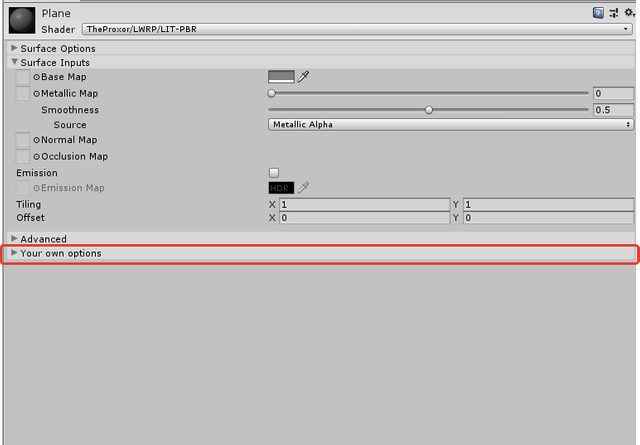
BaseShaderEditor.cs using System; using UnityEngine; using UnityEngine.Rendering; using UnityEditor.Rendering; namespace UnityEditor { public abstract class BaseShaderEditor : ShaderGUI { #region EnumsAndClasses public enum SurfaceType { Opaque, Transparent } public enum BlendMode { Alpha, // Old school alpha-blending mode, fresnel does not affect amount of transparency Premultiply, // Physically plausible transparency mode, implemented as alpha pre-multiply Additive, Multiply } public enum SmoothnessSource { BaseAlpha, SpecularAlpha } public enum RenderFace { Front = 2, Back = 1, Both = 0 } protected class Styles { // Catergories public static readonly GUIContent SurfaceOptions = new GUIContent("Surface Options", "Controls how LWRP renders the Material on a screen."); public static readonly GUIContent SurfaceInputs = new GUIContent("Surface Inputs", "These settings describe the look and feel of the surface itself."); public static readonly GUIContent AdvancedLabel = new GUIContent("Advanced", "These settings affect behind-the-scenes rendering and underlying calculations."); public static readonly GUIContent surfaceType = new GUIContent("Surface Type", "Select a surface type for your texture. Choose between Opaque or Transparent."); public static readonly GUIContent blendingMode = new GUIContent("Blending Mode", "Controls how the color of the Transparent surface blends with the Material color in the background."); public static readonly GUIContent cullingText = new GUIContent("Render Face", "Specifies which faces to cull from your geometry. Front culls front faces. Back culls backfaces. None means that both sides are rendered."); public static readonly GUIContent alphaClipText = new GUIContent("Alpha Clipping", "Makes your Material act like a Cutout shader. Use this to create a transparent effect with hard edges between opaque and transparent areas."); public static readonly GUIContent alphaClipThresholdText = new GUIContent("Threshold", "Sets where the Alpha Clipping starts. The higher the value is, the brighter the effect is when clipping starts."); public static readonly GUIContent receiveShadowText = new GUIContent("Receive Shadows", "When enabled, other GameObjects can cast shadows onto this GameObject."); public static readonly GUIContent baseMap = new GUIContent("Base Map", "Specifies the base Material and/or Color of the surface. If you've selected Transparent or Alpha Clipping under Surface Options, your Material uses the Texture's alpha channel or color."); public static readonly GUIContent emissionMap = new GUIContent("Emission Map", "Sets a Texture map to use for emission. You can also select a color with the color picker. Colors are multiplied over the Texture."); public static readonly GUIContent normalMapText = new GUIContent("Normal Map", "Assigns a tangent-space normal map."); public static readonly GUIContent bumpScaleNotSupported = new GUIContent("Bump scale is not supported on mobile platforms"); public static readonly GUIContent fixNormalNow = new GUIContent("Fix now", "Converts the assigned texture to be a normal map format."); public static readonly GUIContent queueSlider = new GUIContent("Priority", "Determines the chronological rendering order for a Material. High values are rendered first."); public static readonly GUIContent OtherOptions = new GUIContent("Your own options", "You own custom options"); } #endregion #region Variables protected MaterialEditor materialEditor { get; set; } protected MaterialProperty surfaceTypeProp { get; set; } protected MaterialProperty blendModeProp { get; set; } protected MaterialProperty cullingProp { get; set; } protected MaterialProperty alphaClipProp { get; set; } protected MaterialProperty alphaCutoffProp { get; set; } protected MaterialProperty receiveShadowsProp { get; set; } // Common Surface Input properties protected MaterialProperty baseMapProp { get; set; } protected MaterialProperty baseColorProp { get; set; } protected MaterialProperty emissionMapProp { get; set; } protected MaterialProperty emissionColorProp { get; set; } protected MaterialProperty queueOffsetProp { get; set; } public bool m_FirstTimeApply = true; private const string k_KeyPrefix = "LightweightRP:Material:UI_State:"; private string m_HeaderStateKey = null; // Header foldout states AnimatedValues.AnimBool m_SurfaceOptionsFoldout; AnimatedValues.AnimBool m_SurfaceInputsFoldout; AnimatedValues.AnimBool m_AdvancedFoldout; AnimatedValues.AnimBool m_OtherFoldout; #endregion private const int queueOffsetRange = 50; //////////////////////////////////// // General Functions // //////////////////////////////////// #region GeneralFunctions public abstract void MaterialChanged(Material material); public virtual void FindProperties(MaterialProperty[] properties) { surfaceTypeProp = FindProperty("_Surface", properties); blendModeProp = FindProperty("_Blend", properties); cullingProp = FindProperty("_Cull", properties); alphaClipProp = FindProperty("_AlphaClip", properties); alphaCutoffProp = FindProperty("_Cutoff", properties); receiveShadowsProp = FindProperty("_ReceiveShadows", properties, false); baseMapProp = FindProperty("_BaseMap", properties, false); baseColorProp = FindProperty("_BaseColor", properties, false); emissionMapProp = FindProperty("_EmissionMap", properties, false); emissionColorProp = FindProperty("_EmissionColor", properties, false); queueOffsetProp = FindProperty("_QueueOffset", properties, false); } public override void OnGUI(MaterialEditor materialEditorIn, MaterialProperty[] properties) { if (materialEditorIn == null) throw new ArgumentNullException("materialEditorIn"); FindProperties(properties); // MaterialProperties can be animated so we do not cache them but fetch them every event to ensure animated values are updated correctly materialEditor = materialEditorIn; Material material = materialEditor.target as Material; // Make sure that needed setup (ie keywords/renderqueue) are set up if we're switching some existing // material to a lightweight shader. if (m_FirstTimeApply) { OnOpenGUI(material, materialEditorIn); m_FirstTimeApply = false; } ShaderPropertiesGUI(material); m_OtherFoldout.value = EditorGUILayout.BeginFoldoutHeaderGroup(m_OtherFoldout.value, Styles.OtherOptions); if (m_OtherFoldout.value) { base.OnGUI(materialEditorIn, properties); EditorGUILayout.Space(); } EditorGUILayout.EndFoldoutHeaderGroup(); foreach (var obj in materialEditor.targets) MaterialChanged((Material)obj); } public virtual void OnOpenGUI(Material material, MaterialEditor materialEditor) { // Foldout states m_HeaderStateKey = k_KeyPrefix + material.shader.name; // Create key string for editor prefs m_SurfaceOptionsFoldout = new AnimatedValues.AnimBool(true); m_SurfaceInputsFoldout = new AnimatedValues.AnimBool(true); m_AdvancedFoldout = new AnimatedValues.AnimBool(true); m_OtherFoldout = new AnimatedValues.AnimBool(true); foreach (var obj in materialEditor.targets) MaterialChanged((Material)obj); } public void ShaderPropertiesGUI(Material material) { if (material == null) throw new ArgumentNullException("material"); EditorGUI.BeginChangeCheck(); m_SurfaceOptionsFoldout.value = EditorGUILayout.BeginFoldoutHeaderGroup(m_SurfaceOptionsFoldout.value, Styles.SurfaceOptions); if (m_SurfaceOptionsFoldout.value) { DrawSurfaceOptions(material); EditorGUILayout.Space(); } EditorGUILayout.EndFoldoutHeaderGroup(); m_SurfaceInputsFoldout.value = EditorGUILayout.BeginFoldoutHeaderGroup(m_SurfaceInputsFoldout.value, Styles.SurfaceInputs); if (m_SurfaceInputsFoldout.value) { DrawSurfaceInputs(material); EditorGUILayout.Space(); } EditorGUILayout.EndFoldoutHeaderGroup(); m_AdvancedFoldout.value = EditorGUILayout.BeginFoldoutHeaderGroup(m_AdvancedFoldout.value, Styles.AdvancedLabel); if (m_AdvancedFoldout.value) { DrawAdvancedOptions(material); EditorGUILayout.Space(); } EditorGUILayout.EndFoldoutHeaderGroup(); DrawAdditionalFoldouts(material); if (EditorGUI.EndChangeCheck()) { foreach (var obj in materialEditor.targets) MaterialChanged((Material)obj); } } #endregion //////////////////////////////////// // Drawing Functions // //////////////////////////////////// #region DrawingFunctions public virtual void DrawSurfaceOptions(Material material) { DoPopup(Styles.surfaceType, surfaceTypeProp, Enum.GetNames(typeof(SurfaceType))); if ((SurfaceType)material.GetFloat("_Surface") == SurfaceType.Transparent) DoPopup(Styles.blendingMode, blendModeProp, Enum.GetNames(typeof(BlendMode))); EditorGUI.BeginChangeCheck(); EditorGUI.showMixedValue = cullingProp.hasMixedValue; var culling = (RenderFace)cullingProp.floatValue; culling = (RenderFace)EditorGUILayout.EnumPopup(Styles.cullingText, culling); if (EditorGUI.EndChangeCheck()) { materialEditor.RegisterPropertyChangeUndo(Styles.cullingText.text); cullingProp.floatValue = (float)culling; material.doubleSidedGI = (RenderFace)cullingProp.floatValue != RenderFace.Front; } EditorGUI.showMixedValue = false; EditorGUI.BeginChangeCheck(); EditorGUI.showMixedValue = alphaClipProp.hasMixedValue; var alphaClipEnabled = EditorGUILayout.Toggle(Styles.alphaClipText, alphaClipProp.floatValue == 1); if (EditorGUI.EndChangeCheck()) alphaClipProp.floatValue = alphaClipEnabled ? 1 : 0; EditorGUI.showMixedValue = false; if (alphaClipProp.floatValue == 1) materialEditor.ShaderProperty(alphaCutoffProp, Styles.alphaClipThresholdText, 1); if (receiveShadowsProp != null) { EditorGUI.BeginChangeCheck(); EditorGUI.showMixedValue = receiveShadowsProp.hasMixedValue; var receiveShadows = EditorGUILayout.Toggle(Styles.receiveShadowText, receiveShadowsProp.floatValue == 1.0f); if (EditorGUI.EndChangeCheck()) receiveShadowsProp.floatValue = receiveShadows ? 1.0f : 0.0f; EditorGUI.showMixedValue = false; } } public virtual void DrawSurfaceInputs(Material material) { DrawBaseProperties(material); } public virtual void DrawAdvancedOptions(Material material) { materialEditor.EnableInstancingField(); if (queueOffsetProp != null) { EditorGUI.BeginChangeCheck(); EditorGUI.showMixedValue = queueOffsetProp.hasMixedValue; var queue = EditorGUILayout.IntSlider(Styles.queueSlider, (int)queueOffsetProp.floatValue, -queueOffsetRange, queueOffsetRange); if (EditorGUI.EndChangeCheck()) queueOffsetProp.floatValue = queue; EditorGUI.showMixedValue = false; } } public virtual void DrawAdditionalFoldouts(Material material) { } public virtual void DrawBaseProperties(Material material) { if (baseMapProp != null && baseColorProp != null) // Draw the baseMap, most shader will have at least a baseMap { materialEditor.TexturePropertySingleLine(Styles.baseMap, baseMapProp, baseColorProp); // TODO Temporary fix for lightmapping, to be replaced with attribute tag. if (material.HasProperty("_MainTex")) { material.SetTexture("_MainTex", baseMapProp.textureValue); var baseMapTiling = baseMapProp.textureScaleAndOffset; material.SetTextureScale("_MainTex", new Vector2(baseMapTiling.x, baseMapTiling.y)); material.SetTextureOffset("_MainTex", new Vector2(baseMapTiling.z, baseMapTiling.w)); } } } protected virtual void DrawEmissionProperties(Material material, bool keyword) { var emissive = true; var hadEmissionTexture = emissionMapProp.textureValue != null; if (!keyword) { materialEditor.TexturePropertyWithHDRColor(Styles.emissionMap, emissionMapProp, emissionColorProp, false); } else { // Emission for GI? emissive = materialEditor.EmissionEnabledProperty(); EditorGUI.BeginDisabledGroup(!emissive); { // Texture and HDR color controls materialEditor.TexturePropertyWithHDRColor(Styles.emissionMap, emissionMapProp, emissionColorProp, false); } EditorGUI.EndDisabledGroup(); } // If texture was assigned and color was black set color to white var brightness = emissionColorProp.colorValue.maxColorComponent; if (emissionMapProp.textureValue != null && !hadEmissionTexture && brightness <= 0f) emissionColorProp.colorValue = Color.white; // LW does not support RealtimeEmissive. We set it to bake emissive and handle the emissive is black right. if (emissive) { material.globalIlluminationFlags = MaterialGlobalIlluminationFlags.BakedEmissive; if (brightness <= 0f) material.globalIlluminationFlags |= MaterialGlobalIlluminationFlags.EmissiveIsBlack; } } public static void DrawNormalArea(MaterialEditor materialEditor, MaterialProperty bumpMap, MaterialProperty bumpMapScale = null) { if (bumpMapScale != null) { materialEditor.TexturePropertySingleLine(Styles.normalMapText, bumpMap, bumpMap.textureValue != null ? bumpMapScale : null); if (bumpMapScale.floatValue != 1 && UnityEditorInternal.InternalEditorUtility.IsMobilePlatform( EditorUserBuildSettings.activeBuildTarget)) if (materialEditor.HelpBoxWithButton(Styles.bumpScaleNotSupported, Styles.fixNormalNow)) bumpMapScale.floatValue = 1; } else { materialEditor.TexturePropertySingleLine(Styles.normalMapText, bumpMap); } } protected static void DrawTileOffset(MaterialEditor materialEditor, MaterialProperty textureProp) { materialEditor.TextureScaleOffsetProperty(textureProp); } #endregion //////////////////////////////////// // Material Data Functions // //////////////////////////////////// #region MaterialDataFunctions public static void SetMaterialKeywords(Material material, Action<Material> shadingModelFunc = null, Action<Material> shaderFunc = null) { // Clear all keywords for fresh start material.shaderKeywords = null; // Setup blending - consistent across all LWRP shaders SetupMaterialBlendMode(material); // Receive Shadows if (material.HasProperty("_ReceiveShadows")) CoreUtils.SetKeyword(material, "_RECEIVE_SHADOWS_OFF", material.GetFloat("_ReceiveShadows") == 0.0f); // Emission if (material.HasProperty("_EmissionColor")) MaterialEditor.FixupEmissiveFlag(material); bool shouldEmissionBeEnabled = (material.globalIlluminationFlags & MaterialGlobalIlluminationFlags.EmissiveIsBlack) == 0; if (material.HasProperty("_EmissionEnabled") && !shouldEmissionBeEnabled) shouldEmissionBeEnabled = material.GetFloat("_EmissionEnabled") >= 0.5f; CoreUtils.SetKeyword(material, "_EMISSION", shouldEmissionBeEnabled); // Normal Map if (material.HasProperty("_BumpMap")) CoreUtils.SetKeyword(material, "_NORMALMAP", material.GetTexture("_BumpMap")); // Shader specific keyword functions shadingModelFunc?.Invoke(material); shaderFunc?.Invoke(material); } public static void SetupMaterialBlendMode(Material material) { if (material == null) throw new ArgumentNullException("material"); bool alphaClip = material.GetFloat("_AlphaClip") == 1; if (alphaClip) { material.EnableKeyword("_ALPHATEST_ON"); } else { material.DisableKeyword("_ALPHATEST_ON"); } var queueOffset = 0; // queueOffsetRange; if (material.HasProperty("_QueueOffset")) queueOffset = queueOffsetRange - (int)material.GetFloat("_QueueOffset"); SurfaceType surfaceType = (SurfaceType)material.GetFloat("_Surface"); if (surfaceType == SurfaceType.Opaque) { if (alphaClip) { material.renderQueue = (int)UnityEngine.Rendering.RenderQueue.AlphaTest; material.SetOverrideTag("RenderType", "TransparentCutout"); } else { material.renderQueue = (int)UnityEngine.Rendering.RenderQueue.Geometry; material.SetOverrideTag("RenderType", "Opaque"); } material.renderQueue += queueOffset; material.SetInt("_SrcBlend", (int)UnityEngine.Rendering.BlendMode.One); material.SetInt("_DstBlend", (int)UnityEngine.Rendering.BlendMode.Zero); material.SetInt("_ZWrite", 1); material.DisableKeyword("_ALPHAPREMULTIPLY_ON"); material.SetShaderPassEnabled("ShadowCaster", true); } else { BlendMode blendMode = (BlendMode)material.GetFloat("_Blend"); var queue = (int)UnityEngine.Rendering.RenderQueue.Transparent; // Specific Transparent Mode Settings switch (blendMode) { case BlendMode.Alpha: material.SetInt("_SrcBlend", (int)UnityEngine.Rendering.BlendMode.SrcAlpha); material.SetInt("_DstBlend", (int)UnityEngine.Rendering.BlendMode.OneMinusSrcAlpha); material.DisableKeyword("_ALPHAPREMULTIPLY_ON"); break; case BlendMode.Premultiply: material.SetInt("_SrcBlend", (int)UnityEngine.Rendering.BlendMode.One); material.SetInt("_DstBlend", (int)UnityEngine.Rendering.BlendMode.OneMinusSrcAlpha); material.EnableKeyword("_ALPHAPREMULTIPLY_ON"); break; case BlendMode.Additive: material.SetInt("_SrcBlend", (int)UnityEngine.Rendering.BlendMode.One); material.SetInt("_DstBlend", (int)UnityEngine.Rendering.BlendMode.One); material.DisableKeyword("_ALPHAPREMULTIPLY_ON"); break; case BlendMode.Multiply: material.SetInt("_SrcBlend", (int)UnityEngine.Rendering.BlendMode.DstColor); material.SetInt("_DstBlend", (int)UnityEngine.Rendering.BlendMode.Zero); material.DisableKeyword("_ALPHAPREMULTIPLY_ON"); material.EnableKeyword("_ALPHAMODULATE_ON"); break; } // General Transparent Material Settings material.SetOverrideTag("RenderType", "Transparent"); material.SetInt("_ZWrite", 0); material.renderQueue = queue + queueOffset; material.SetShaderPassEnabled("ShadowCaster", false); } } #endregion //////////////////////////////////// // Helper Functions // //////////////////////////////////// #region HelperFunctions public static void TwoFloatSingleLine(GUIContent title, MaterialProperty prop1, GUIContent prop1Label, MaterialProperty prop2, GUIContent prop2Label, MaterialEditor materialEditor, float labelWidth = 30f) { EditorGUI.BeginChangeCheck(); EditorGUI.showMixedValue = prop1.hasMixedValue || prop2.hasMixedValue; Rect rect = EditorGUILayout.GetControlRect(); EditorGUI.PrefixLabel(rect, title); var indent = EditorGUI.indentLevel; var preLabelWidth = EditorGUIUtility.labelWidth; EditorGUI.indentLevel = 0; EditorGUIUtility.labelWidth = labelWidth; Rect propRect1 = new Rect(rect.x + preLabelWidth, rect.y, (rect.width - preLabelWidth) * 0.5f, EditorGUIUtility.singleLineHeight); var prop1val = EditorGUI.FloatField(propRect1, prop1Label, prop1.floatValue); Rect propRect2 = new Rect(propRect1.x + propRect1.width, rect.y, propRect1.width, EditorGUIUtility.singleLineHeight); var prop2val = EditorGUI.FloatField(propRect2, prop2Label, prop2.floatValue); EditorGUI.indentLevel = indent; EditorGUIUtility.labelWidth = preLabelWidth; if (EditorGUI.EndChangeCheck()) { materialEditor.RegisterPropertyChangeUndo(title.text); prop1.floatValue = prop1val; prop2.floatValue = prop2val; } EditorGUI.showMixedValue = false; } public void DoPopup(GUIContent label, MaterialProperty property, string[] options) { DoPopup(label, property, options, materialEditor); } public static void DoPopup(GUIContent label, MaterialProperty property, string[] options, MaterialEditor materialEditor) { if (property == null) throw new ArgumentNullException("property"); EditorGUI.showMixedValue = property.hasMixedValue; var mode = property.floatValue; EditorGUI.BeginChangeCheck(); mode = EditorGUILayout.Popup(label, (int)mode, options); if (EditorGUI.EndChangeCheck()) { materialEditor.RegisterPropertyChangeUndo(label.text); property.floatValue = mode; } EditorGUI.showMixedValue = false; } // Helper to show texture and color properties public static Rect TextureColorProps(MaterialEditor materialEditor, GUIContent label, MaterialProperty textureProp, MaterialProperty colorProp, bool hdr = false) { Rect rect = EditorGUILayout.GetControlRect(); EditorGUI.showMixedValue = textureProp.hasMixedValue; materialEditor.TexturePropertyMiniThumbnail(rect, textureProp, label.text, label.tooltip); EditorGUI.showMixedValue = false; if (colorProp != null) { EditorGUI.BeginChangeCheck(); EditorGUI.showMixedValue = colorProp.hasMixedValue; int indentLevel = EditorGUI.indentLevel; EditorGUI.indentLevel = 0; Rect rectAfterLabel = new Rect(rect.x + EditorGUIUtility.labelWidth, rect.y, EditorGUIUtility.fieldWidth, EditorGUIUtility.singleLineHeight); var col = EditorGUI.ColorField(rectAfterLabel, GUIContent.none, colorProp.colorValue, true, false, hdr); EditorGUI.indentLevel = indentLevel; if (EditorGUI.EndChangeCheck()) { materialEditor.RegisterPropertyChangeUndo(colorProp.displayName); colorProp.colorValue = col; } EditorGUI.showMixedValue = false; } return rect; } // Copied from shaderGUI as it is a protected function in an abstract class, unavailable to others public new static MaterialProperty FindProperty(string propertyName, MaterialProperty[] properties) { return FindProperty(propertyName, properties, true); } // Copied from shaderGUI as it is a protected function in an abstract class, unavailable to others public new static MaterialProperty FindProperty(string propertyName, MaterialProperty[] properties, bool propertyIsMandatory) { for (int index = 0; index < properties.Length; ++index) { if (properties[index] != null && properties[index].name == propertyName) return properties[index]; } if (propertyIsMandatory) throw new ArgumentException("Could not find MaterialProperty: '" + propertyName + "', Num properties: " + (object)properties.Length); return null; } #endregion } }
LitShaderEditor.cs using System; using UnityEngine; using UnityEngine.Rendering; using UnityEditor.Rendering.LWRP; namespace UnityEditor.Rendering.LWRP.ShaderGUI { internal class LitShaderEditor : BaseShaderEditor {
Schauen wir uns nun die Innenseiten des Shaders an.Das erste, worauf Sie achten, ist, dass der Shader nur fünf Pässe enthält. Lassen Sie uns ein wenig auf sie eingehen:- ForwardLit: Forward Pass, hier betrachten wir Licht, PBR und Nebel.
- ShadowCaster: Hier ist die Berechnung der Schatten.
- DepthOnly: Tiefe (Z-Puffer).
- Meta: Gebackenes Licht (Lightmaps).
- Lightweight2D: Sprites und UI.
Darüber hinaus verfügt Unity über verschiedene Shader-Compiler und Cross-Compiler. SRP erfordert HLSLcc. Auf Plattformen, die die OpenGL ES-Grafik-API verwenden (z. B. Android), wird HLSLcc standardmäßig nicht verwendet.Deshalb erzwingen wir es zu verbinden: #pragma prefer_hlslcc gles
DirectX 9 wird jedoch nicht unterstützt. Deaktivieren Sie es daher zwangsweise: #pragma exclude_renderers d3d11_9x
In Bezug auf das Schreiben des Codes selbst hat sich nichts geändert, außer dass wir jetzt nicht in CG, sondern in reinem HLSL schreiben und daher der Body des Shader-Programms jetzt so aussehen wird: HLSLPROGRAM ... ENDHLSL
Außerdem haben wir weiterhin Zugriff auf vertraute globale Variablen wie _Time , _ScreenParams oder _WorldSpaceCameraPos . Viele in UnityCG.cginc beschriebene Standardfunktionen stehen uns jedoch nicht mehr zur Verfügung. In den meisten Fällen gilt dies für verschiedene Matrix transorfmatsy zum Beispiel ein analoges UnityObjectToClipPos (POSITION) ist TransformWorldToHClip (die Position) , gut oder Nebel - stattdessen UNITY_APPLY_FOG (fogCoord, Farbe) jetzt ispozuem wir MixFog (Farbe, fogCoord) .Tatsächlich folgt man demselben magischen Pfad und findet die Datei Core.hlsl:% localappdata% \ Unity \ cache \ packages \ packages.unity.com \ com.unity.render-pipelines.lightweight @ (LWRP-Version) \ ShaderLibrary \ Core.hlsl
Wir finden eine vollständige Liste der verfügbaren Funktionen.Erwähnenswert sind auch konstante Puffer (CBUFFER) und UnityPerMaterial. Konstante Puffer werden zum Speichern von Daten verwendet, die auf der GPU selten geändert werden. Sie können zum Speichern von Shader-Variablen verwendet werden. Rufen Sie dazu einfach die MakrosCBUFFER_START und CBUFFER_END auf : CBUFFER_START(UnityPerMaterial) float4 _BaseMap_ST; half4 _BaseColor; half4 _SpecColor; half4 _EmissionColor; half _Cutoff; half _Smoothness; half _Metallic; half _BumpScale; half _OcclusionStrength; CBUFFER_END
Die Deklaration globaler oder verschiedener parametrisch festgelegter Variablen (z. B. aus Code oder Animation) erfolgt auf die altmodische Weise im Inneren eines Shader-Programms.LWRP verwendet zwei Arten von konstanten Puffern: UnityPerObject und UnityPerMaterial . Diese Puffer werden einmal gebunden, damit sie während des Renderns verwendet werden können. Grob gesagt bedeutet dies, dass während des Ziehens konstante Puffer nicht wieder verstärkt werden oder kein Sollwert für Materialien benötigt wird. Dies ist von Vorteil, wenn mehrere Shader denselben konstanten Puffer verwenden, da LWRP hierfür unterschiedliche Materialien verpacken kann.Wenn Sie die Struktur des Shaders sorgfältig untersuchen, werden Sie feststellen, dass die meisten Standarddaten nur überall konstante Puffer verwenden.Ausführlicher über alle Unterschiede, aber auf Englisch können Sie hier lesen .Übrigens, wenn Sie sich SurfaceData genauer ansehen: SurfaceData surfaceData;
Sie werden vielleicht feststellen, dass dies der geschätzte PBR-Meister von ShaderGraph ist .Beispiel
So, jetzt sind unsere Hände völlig losgebunden, was bedeutet, dass die Zeit gekommen ist, ein Bacchanal zu arrangieren! Fügen wir als Beispiel Vertex Displacement und Dissolve Effect hinzu und lassen Sie den Rest tanzen. Es ist sehr praktisch, dass sich alle Ausweise vor unseren Augen befinden und wir alles umfassend bearbeiten können. Beschreiben wir die Eigenschaften: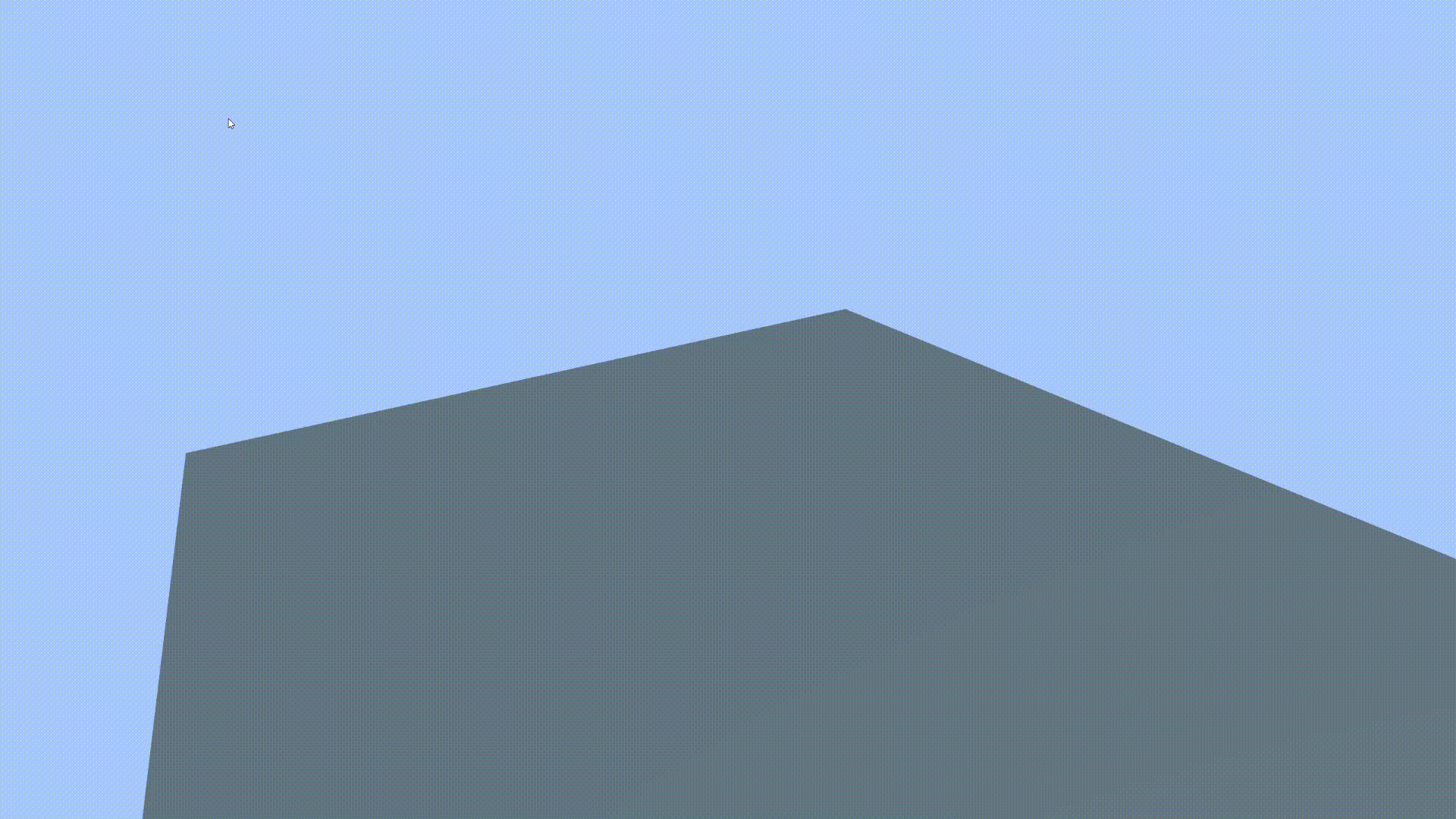
Properties { ... _DissolveMap("Dissolve Map", 2D) = "white" {} _DissolveFactor("Dissolve Factor", Range(0, 1)) = 0.0 _DissolveWidth("Dissolve Width", Range(0, 1)) = 0.0 [HDR]_DissolveColor("Color", Color) = (1,1,0) }
Was zweifellos auf unserer eigenen und beliebten Registerkarte im Inspektor angezeigt wird: Variablen hinzufügen: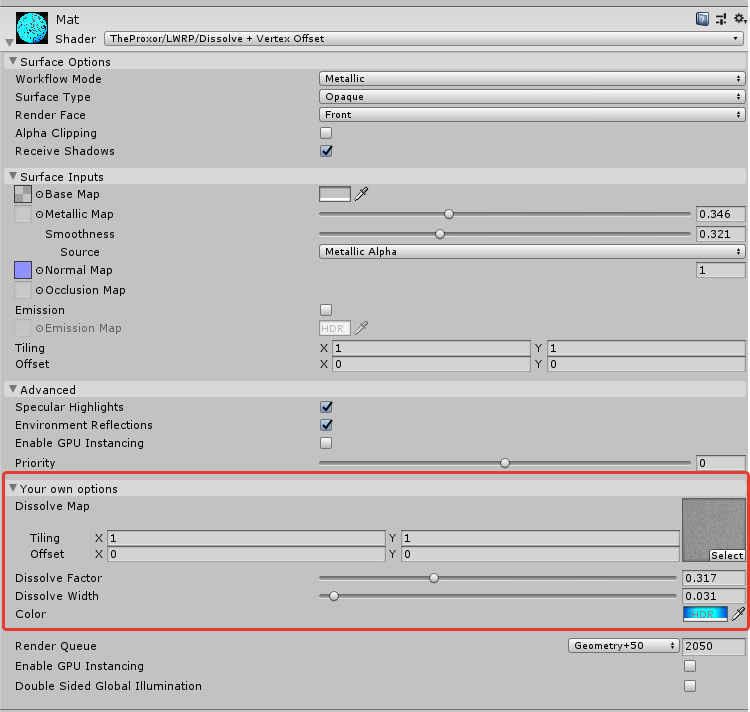
CBUFFER_START(UnityPerMaterial) ... float4 _DissolveMap_ST;
Senden Sie zunächst die Geometrie an einen Betrunkenen: Varyings LitPassVertex(Attributes input) { ... input.positionOS.xyz += normalize(input.positionOS.xyz) * sin(input.positionOS.x) * sin(_Time.x * 100); ... }
Dann der Schatten: Varyings ShadowPassVertex(Attributes input) { ... input.positionOS.xyz += normalize(input.positionOS.xyz) * sin(input.positionOS.x) * sin(_Time.x * 100); ... }
Tiefe: Varyings DepthOnlyVertex(Attributes input) { ... input.position.xyz += normalize(input.position.xyz) * sin(input.position.x) * sin(_Time.x * 100); ... }
Nun, jetzt löse Zeit und Bewegung auf: half4 LitPassFragment(Varyings input) : SV_Target { ...
Sie können Dissolve auch in den Schatten bringen. Mit einem Handgriff erhalten Sie dann den richtigen Schatten, der im Shader-Diagramm nur schwer zu erzielen ist. Hier sind nur ein paar Codezeilen. half4 ShadowPassFragment(Varyings input) : SV_TARGET { ... float4 mask = SAMPLE_TEXTURE2D(_DissolveMap, sampler_DissolveMap, input.uv); if (mask.r > _DissolveFactor) discard; ... }
Nun, der letzte Shader-Code:SimpleDissolve Shader "TheProxor/LWRP/Dissolve + Vertex Offset" { Properties {
Fazit
Nun, hier ist es Zeit, Bilanz zu ziehen. Wie sich herausstellte, ist es in LWRP möglich und sogar erforderlich, Shader mit Code zu schreiben, da dies Ihre Hände erheblich entlastet und Ihnen dabei hilft, coole Dinge ohne Krücken zu schreiben, z. B. Ihr Beleuchtungssystem. Natürlich kann dies nicht mit dem praktischen und vertrauten Standard Surface Shader verglichen werden , aber vielleicht werde ich eines Tages die Hände bekommen, um das gleiche praktische Analogon für LWRP und HDRP zu schreiben, aber dazu ein anderes Mal mehr.Nützliche Links:
Aufbewahrungsort mit allen Materialien des ArtikelsGefunden bei der Vorbereitung des Materials, inoffizielle DokumentationLWRP-Dokumentation